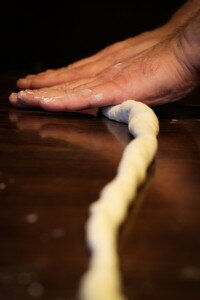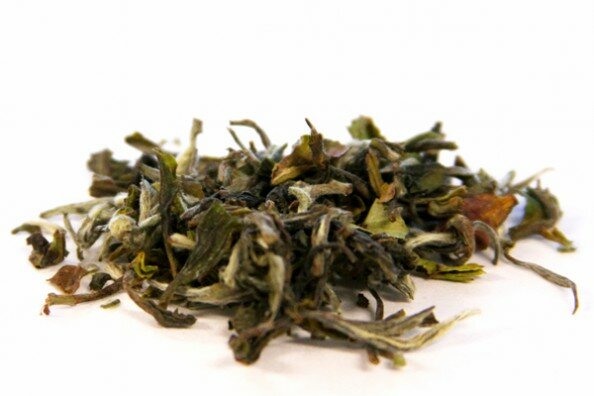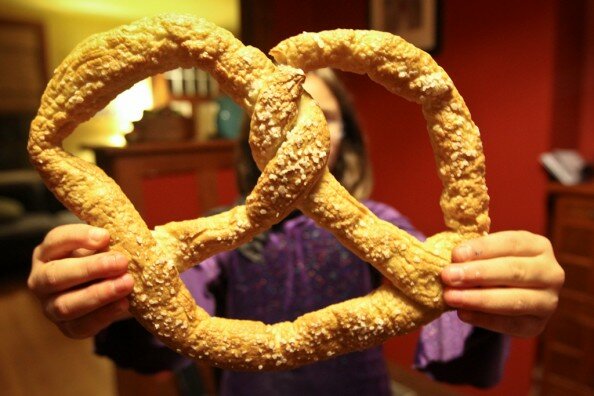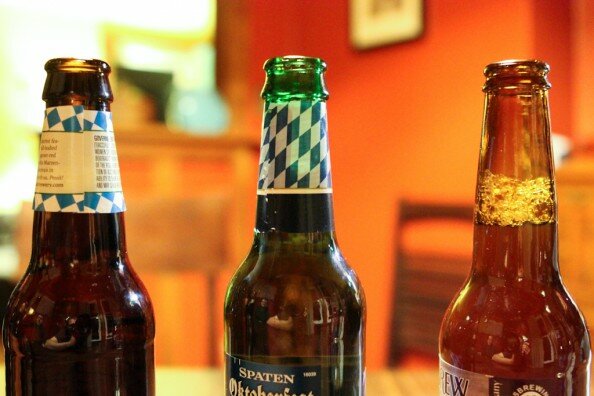
Monthly Archives: October 2011
Gourmet Underground Detroit's content archives are organized by date and catalog the aggregated content of our Features pages as well as our blog.
How to Make a Meat Head
The concept is simple – drape thinly sliced, cured meat over a skull. But in case you are wondering how we made ours, here is the step-by-step process:
Step 1. Adhere a washed, plastic human skull to a serving platter using hot glue or nails. You can find plastic skulls in any large department store. Ours was produced by artisans in Shenzhen, China.
Step 2. Drill small holes into the center of the eye sockets sized to accept toothpicks. Alternatively, you could hot glue toothpick pieces to the eye sockets.
Step 3. Make the eyes using cocktail onions with embedded olives for the pupils. Attach to the toothpicks in the eye sockets. Pimento stuffed olives or those nuclear-colored maraschino cherries would work too.
Step 4. Drape skull with meat. Thinly sliced prosciutto works well. Something more red in color like hot capicola or chorizo would be cool. Make sure it’s sliced thin. Fat helps the meat stick to the skull.
Step 5. Add cheese, crackers, olives, or whatever you normally add to a meat and cheese platter.
Step 6. Enjoy!
Table Wine that Travels, Tastes Good, and Reduces Environmental Impact.
Thanks to Franzia and their line of three and five liter boxes of adult juice drink (some of which appear not to be wine at all), wine packaged in anything but glass has a reputation for poor quality. But perceptions are slowly and surely changing. Brands like Jenny & Francois’s From the Tank and J. Soif’s Yellow + Blue, among others, are proving that alternative packaging doesn’t have to be filled with plonk wine.
 When I needed a full liter of inexpensive wine to fill my Spanish wine skin for Marche du Nain Rouge this past spring, I snagged a container of Y + B malbec. Produced with organically grown, hand-harvested Argentinean grapes and fermented in steel tanks with indigenous yeast, it’s a quality, poundable wine with ample fresh dark fruit flavors balanced by light tannins and a fine acidity – a good value at $10. Though the carnival atmosphere down Cass Ave. and into Cass Park certainly helped, I was pleasantly surprised at how much I genuinely enjoyed this boxed wine. And the bota bag was quite handy when it came time to share with a friend limited in motion by the dozens of stuffed animals sewn onto his clothing.
When I needed a full liter of inexpensive wine to fill my Spanish wine skin for Marche du Nain Rouge this past spring, I snagged a container of Y + B malbec. Produced with organically grown, hand-harvested Argentinean grapes and fermented in steel tanks with indigenous yeast, it’s a quality, poundable wine with ample fresh dark fruit flavors balanced by light tannins and a fine acidity – a good value at $10. Though the carnival atmosphere down Cass Ave. and into Cass Park certainly helped, I was pleasantly surprised at how much I genuinely enjoyed this boxed wine. And the bota bag was quite handy when it came time to share with a friend limited in motion by the dozens of stuffed animals sewn onto his clothing.
The Spanish rosé is a juicy mix of organic Monastrell and Syrah grapes with a long mineral finish. This particular blend established itself this summer as a preferred camping wine. Not only does the rectangular box fit well into a cooler, the screw top makes it easier to handle out-of-doors. I’ve also found that it heightens your senses as the sun goes orange behind the pines, the campfire crackles, and the Barred Owls begin their poignant cries from deep inside the dusky wood.
Though I’ve had less experience with the two whites, I can say that the fruity and floral Argentinean Torrontes drank quite easily passed around while lounging in a swimming hole in the Huron River. Kayakers passing by were none the wiser for our daytime drinking adventures.
Y + B packaging isn’t only about the convenience. By using lightweight TetraPak containers traditionally associated with juice boxes, and shipping the wine to North America to be packaged, the importer is able to cut both the cost and carbon footprint roughly in half (yellow plus blue equals green, right). In this modern era, every little bit helps.
While drinking Y + B likely isn’t going to change your life, they are affordable and quality table wines suitable for both field and dining room consumption. All four varieties are available at Western Market in Ferndale.
The Sugar House Opens: A Look Inside the First Day
Just about any bar anywhere would kill to have the publicity and media attention garnered by the Sugar House over the past year. A Metro Times cover. Then an Hour Detroit article. More recently, an Hour Detroit cover. An inclusion of the blog on a Saveur list of 50 must-reads for foodies. And mentions from the BBC travel page, the NY Post, and The New York Times.
The funny part, of course, is that it was simply the promise of what this bar could deliver that drew the hype: During all that coverage, the Sugar House wasn’t even open.
All that changed last Tuesday when manager/bartender Dave Kwiatkowski unlocked his door on Michigan Avenue and served up drinks at the bar’s soft opening. Naturally, I did what any dedicated gourmand lush in search of a cocktail would do: I dropped everything, took a vacation day at work, and decided to capture in photos how the day would ultimately unfold.
(Once you click on the image below to launch the slideshow, you can use the mouse or the arrow keys to cycle through the images.)
Cocktails have become an almost revered form of public alchemy, and there’s a sexy mystique that has begun to surround particular bars, drinks, and the bartenders who make them. At 11pm, when the lights are dim and the gentle mist of a twisted lemon peel is giving your drink that perfect final note, that’s not an entirely unreasonable conclusion.
But as with any small business, the details that create that mystique are a bit less glorious. Dave has rather famously been dealing with red tape for eighteen months, and he had to complete a lot of construction in order to open.
Even on opening day, there wasn’t any real time to celebrate. Since he had no idea when his license would ultimately be approved, he didn’t already have all the right ice on hand, so friends brought him nice, perfect cubes of ice, and they shopped for a box of rye whiskey to help him open. He had to drive to the various liquor distribution hubs around town and collect his initial inventory – except that the distributors had run out of a number of things, including commonplace items like Sazerac rye. And so on.
Still, the daily routine of opening a cocktail bar is about what you’d expect: Dave, bartender Chuck Gellasch, and their bar backs juicing ginger, lemons, and limes; making syrups; mopping floors; stocking shelves; filling ice bins; et cetera.
Having gone largely unadvertised, the first hours of the Sugar House’s first day carried a modest, pleasant pace with a trickle of Slows’ employees, Dave’s friends, and neighborhood folks stopping in for a drink or six. There wasn’t any fanfare – Dave didn’t even have time after his prep work to change into the bar’s signature vest and tie ensemble – there were just good drinks, good folks, and a good night.
He’s still bringing in furniture, hanging artwork, and rounding out his selection of spirits, but all indications are the hype is worth it: The drinks are simply fantastic. But was it worth the wait and the hassle for Dave? It should suffice to say that I’ve never seen anyone so genuinely happy to be fetching a mop or stocking a shelf with bourbon.
Crafting a Better Cuba Libre
Though its exact origins are a mystery, the Cuba Libre was invented near 1900 in, you guessed it, Cuba. Washington Post spirits writer Jason Wilson takes a deeper look into the history of this simple mixture of rum, cola and lime. Today we know the Cuba Libre as an even simpler bar standard of rum and Coke that’s hardly useful for anything but getting wasted. But it doesn’t have to be this way. Quality ingredients and a straightforward addition of bitters will produce a far tastier and certainly a more historically correct version of this classic drink. Rise up!
Recipe
1-1/2 to 2 ounces rum: While most rum is made by fermenting and distilling molasses, a byproduct of the sugar refining process, Trinidad’s 10 Cane rum is created from the first pressing of Trinidadian sugar cane (basically a Rhum Agricole). 10 Cane is distilled twice in small batches in French pot stills and then aged for 6 months in vintage French oak barrels. The result is light, golden rum with mild flavors of pear and vanilla ideal for premium cocktail mixing.
There are plenty of options though. Dark, aged rum will obviously impart its unique flavor characteristics and cheap, white rum will lay a more neutral base. 10 Cane is a good in-between choice.
Juice from half a lime: There is no substitute for freshly squeezed. You can throw the spent lime half into the drink, you can garnish the finished cocktail with a fresh lime wheel, or both.
Cola: Here is where you can really turn a basic rum and Coke into a more elegant drink. Fentimans Curiousity Cola is made by brewing and fermenting herbs and milled roots over seven days. After cola flavoring is added, the soft drink has a depth that blows every other mass produced cola off the shelf. It will make a sexy-hot Cuba Libre.
Premium colas like Virgil’s and Boylan can also be used. Even Coke will make a decent Cuba Libre as long as attention is paid to the other ingredients.
1-3 dashes Angostura bitters: If using Fentimans cola, the bitters are optional or can be cut to only a dash. Any other cola will call for at least two dashes of bitters to help balance out the sweetness.
1-2 teaspoons Allspice Dram (optional): Rarely do we extol the splendor of drinks that aren’t available in Michigan but St. Elizabeth Allspice Dram is a bottle we’ll order from out of state. Traditionally known as pimento dram (pimento is the West Indies term for allspice), this liqueur made from Jamaican pot-still rum and allspice berries is cherished for its extraordinary flavors of clove, cinnamon and nutmeg. Not only does it add island flavor to Caribbean cocktails and tiki drinks, it works well in a wide variety of holiday desserts. It will elevate a Cuba Libre — particularly one made with Coke.
Preparation
Squeeze the lime half into a Collins glass. Add 3 or 4 ice cubes. Pour in the rum and top with cola. Add the bitters and optional Allspice Dram. Do a quick, gentle stir to incorporate the ingredients.
Celebrate the Season
We don’t need a reason to drink beer. But every year around this time, while thousands of people in Munich, Germany are raising liter mugs filled with tasty lager, we get a little restless. It’s as though a metaphysical force reaches over continents and across the Atlantic Ocean imploring us to party. So it only made sense to gather a few people and attempt to make a batch of big-ass pretzels while drinking as much Oktoberfest beer as we could.
Despite its name, the Munich Oktoberfest is actually celebrated through the last couple weeks of September and ends on the first weekend in October. The festival originated in 1810 to observe the marriage of the Crown Prince Ludwig to Princess Therese of Saxony-Hildburghausen. Today, it is the world’s largest fair and an important part of Bavarian culture. With massive drinking tents, carnival rides, traditional German fare, and an outrageous amount of beer, the festival is known throughout the world.
I was lucky enough to be in Munich during Oktoberfest some years ago. Pictures cannot do justice to the atmosphere in the Hofbräu-Festzelt, the largest of all the beer tents. This tent alone sells around half a million liters of beer and 70,000 roast chickens every year through the 16 day event. Imagine yourself drinking beer all day and singing along with a few thousand new friends while an Oom-pah band plays traditional drinking songs like Ein Prosit and, oddly enough, John Denver’s Country Roads. Apparently, beer drinkers like John Denver.
Naturally, it’s easy to overindulge at Munich’s Oktoberfest. Though I consumed multiple liters and even attempted to pick a fight with an English rugby team on one occasion, I was able to narrowly avoid becoming one of the “Bierleichen” (beer corpses). I did see a couple of people puking into garbage cans but that aspect wasn’t much different than Michigan State’s campus before an afternoon football game.
It’s a once-in-a-lifetime experience to be sure and perhaps one of my fondest memories was eating soft pretzels the size of a small Rottweiler.
 There is no big secret to making a decent soft pretzel. It’s just bread that gets a quick bath in boiling water before baking to create a deep-brown outer crust. Making those authentic, big-ass Oktoberfest pretzels is a different story, and our experiment didn’t quite turn out as anticipated. Handling the large twists of delicate dough after the water bath requires some specialized equipment. We were able to accomplish the water bath using a shallow, extra large stainless pot with a deep-frying basket. Though big-ass pretzels are quite impressive, we suggest going a less demanding route and making them small enough to handle with a slotted spoon.
There is no big secret to making a decent soft pretzel. It’s just bread that gets a quick bath in boiling water before baking to create a deep-brown outer crust. Making those authentic, big-ass Oktoberfest pretzels is a different story, and our experiment didn’t quite turn out as anticipated. Handling the large twists of delicate dough after the water bath requires some specialized equipment. We were able to accomplish the water bath using a shallow, extra large stainless pot with a deep-frying basket. Though big-ass pretzels are quite impressive, we suggest going a less demanding route and making them small enough to handle with a slotted spoon.
Recipe for 1 dozen 6-inch Pretzels
Ingredients:
- 2-3/4 cups flour
- 1 tbsp Yeast
- 1 tbsp Sugar
- 1 tsp Salt
- 2 tbsp softened butter
- 1 cup warm water (~115 deg F)
- Coarse salt (we like thin, flaked salt. Try Davids Kosher)
Steps:
- Combine the water and yeast in a mixing bowl. When dissolved and beginning to froth, add 1-1/2 cup flour and remaining ingredients. Stir until thoroughly mixed.
- Stir in the remaining 1-1/4 cup flour and knead until the dough loses its stickiness. Let the dough rise in a covered, greased bowl until it doubles in bulk.
- Punch down the dough and divide into 12 pieces for traditional pretzels or two pieces for big-ass pretzels.
- With your palms, roll the 12 pretzel pieces into 18-inch lengths about the thickness of a pencil, tapering the ends slightly. Loop the 18-inch length into the traditional pretzel shape, and place on a greased baking sheet.
- Cover pretzels and allow the dough to rise until approximately doubled in bulk.
- Preheat oven to 475. In a non-aluminum saucepan, prepare a boiling solution of:
- 4 cups water
- 5 tablespoons baking soda
- With a slotted spoon, carefully lower the pretzels into the water for about one minute.
- Return the pretzels to the greased baking sheet (or alternately, a baking sheet lined with parchment paper or silicone mat) and sprinkle with coarse salt.
- Bake the pretzels until they are browned, about 12-15 minutes.
 Serve with mustard and beer. Which beer? We’re glad you asked.
Serve with mustard and beer. Which beer? We’re glad you asked.
Oktoberfest beer, or Märzen, is a style that was traditionally brewed in spring to be cellared over the summer months. The alcohol content was slightly higher to prevent spoilage. It should be malty, clean, and deep golden to amber in color with no little to no hop flavor or aroma.
Because of the many American craft breweries that make a seasonal ale and call it an Oktoberfest, there is a common misconception that these beers should be deep amber to brown in color, fruity, and sometimes even hoppy. While we’re certainly not beer style fascists and like to take a beer on its own merit as well as compare it to a style, it does get annoying when some beer geeks disparage the lighter German Oktoberfest beers for not being made “to style”. It helps to remember that the Germans invented the damn style and imported German Oktoberfest beer is always a lager and will generally be lighter and cleaner than their American counterparts.
The official Oktoberfest may be over in Munich but many of the beers will remain on store shelves well into November. Drink up.
The Beers
Short’s Noble Chaos: Musty, grainy, and chocolate-y, this lager shows why most American breweries don’t even attempt true Oktoberfest lagers, opting for malty ales instead.
Spaten: Nicely balanced and light bodied, this finishes with a moderate bitterness. Not a remarkable beer but it’s a drinkable brew in a style that can sometimes be a bit too sweet. It’s possible our sample bottle had a bit of skunk. I’m not paranoid of beer in green bottles — but if they are sitting on a warm shelf under lights, buyer beware.
Harpoon: One of the better American Oktoberfests we sampled, this was more “on style” (in the German sense) than most of the other new world selections. Lighter than most, it was nevertheless malty, a tad fruity, and on the sweet side. Quaffable.
Ayinger: Sweeter and fuller bodied than most of the Germans, this would be hard to drink en masse, but it has its own merits: There’s a lot of depth to the malt characteristics, and for all the sweetness, it finishes fairly dry.
Bell’s: Smells and tastes a bit soapy with a grainy and bready texture. This one had a somewhat unfinished quality to it.
Hofbrau: Arguably the lightest beer in terms of body, it’s still quite malty. While it’s not as sweet overall as some others, it has no bitterness on the finish to clean it up so it comes off as awkward.
Sam Adams: We were pleasantly surprised by this beer, which has historically come off to us as a lower tier effort in the style. Compared to the Hofbrau, which preceded it, the Sam was notably weightier in body but less sweet overall. We went back to this later, and while coming after the Hofbrau was a favorable spot in the line-up, it still tasted surprisingly good later. Slightly more hop presence than the Germans, however.
Frankenmuth: Though drinkable outside the context of a tasting, this local version has an off flavor that makes it mediocre at best.
Schmohz: If the Short’s was a bit off style, the Schmohz shows a blatant disregard for what can reasonably be called Oktoberfest. A dark wheat beer, it was laudably dry, but it tasted like an amateur homebrew.
Paulaner: Almost unanimously the best of the Oktoberfest beers, this had the best balance of malt sweetness up front and a dry, lingering finish. As with most lagers and despite the intentional sweetness, drinkability is paramount with Oktoberfest, and Paulaner hits the sweet spot. Even after going back to the other German beers, this stands out in a casual re-tasting.
Weihenstephaner: Though not a part of our tasting I felt it important to mention this beer as I’ve consumed nearly two cases since the season began. With a malty, full body and just enough hop bitterness for balance, this is one of the more drinkable offerings out there.
Images and the bulk of tasting notes provided by Evan Hansen.
A Trio of Teas
Coffee has dominated my consumption of caffeinated beverages of late. I bought the proper pourover gear from my pal James at Great Lakes. Then I got a burr grinder and Chemex to make coffee in the office, and my colleagues and I take turns supplying beans. And now, with the reliably excellent Astro Coffee so close to my usual haunts, I’ve more or less set up a second home in front of their Synesso espresso machine.
But there’s something about fall that can make me crave tea. Generally, I go to Goldfish Tea in Royal Oak, which has a superb selection of teas they import from China. But I was in the mood for some robust, sturdy, English tea time type of stuff — so I recently put in a sizable order with Upton Tea Importers out of Massachusetts.
These three in particular have been real treats:
Margaret’s Hope Estate, 1st Flush 2011 Darjeeling FTGFOP1
I’m hardly an expert on tea, but I’ve been drinking it for quite a while, and one of the reasons I love Darjeeling is the wide variation in production methods and the willingness to ignore the obvious, commodity-based classifications for tea. That is to say, it’s not “green” or “black” or “oolong.” In fact, I’d guess most people think of Darjeeling as black, but it’s arguably closer to oolong.
This particular tea is somewhere in the green/oolong range. Wiry, twisted, green leaves are interspersed with darker leaves and ample silvery, fuzzy tips. Even just from its “tippy” appearance, it’s clear that this is top shelf stuff.
The leaves have a bit of a raw, grassy aroma, but far more so, they’re quite sweet-smelling – a bit like dried hibiscus or cracked rose hips.

Different estates have different characteristics, of course, as the elevation, temperature, weather, and sun exposure are different (not to mention the processing methods). I’d never had a Margaret’s Hope estate tea before, and I can’t speak to the unique characteristics of this 1st flush (which refers to softer teas harvested in March rather than the more widely known teas from the June season) versus another estate’s – but this is really very lovely stuff.
The nose is youthful and green with a delicate redolence, like sugar syrup and flowers. On the palate, it’s similarly refined with a tropical flavor. Upton suggests “pineapple” as a descriptor, but more so, it’s this vague impression of refreshment despite sweetness. At $33 per 80g, this is not something any random tea drinker might want to purchase on a whim. But anyone who wants to really explore the wide range of flavors that tea can have should consider trying something like this. It displays very particular, elegant flavors that only Darjeeling is capable of producing.
Lavender Earl Grey
Whoever came up with the idea to blend Earl Grey tea with lavender is a genius. Traditional Earl Grey, of course, is a loose leaf black tea (It could be from China or India; I think most tea lovers believe that the first black tea base for Earl Grey came from China, but modern producers make no distinction) that is blended with Bergamot. The oils are extracted from that Asian citrus fruit and added to the tea, which lends both flavor and especially aroma.
Anyone who’s had real leaf Earl Grey with natural Bergamot rather than bagged tea or something flavored with synthetic oils knows that the citrus lends a powerful nose to the dry leaf as well as to the cup.
So I had my doubts as to whether or not a similarly dominant aromatic like lavender would work with Bergamot. But Upton Tea knows their shit, and one of the reviewers – who often also know their shit – commented specifically about the lavender being a surprisingly pleasant addition.
As it turns out, that was a bit of an understatement.
This is arguably my favorite scented tea ever. Granted, I’m a bit of a lavender slut (OK perhaps “fiend” or “lover” would have been a more appropriate word), but the floral nose of the dry leaf is intoxicating and the aromatics in the brewed cup are nice and subtle. There are bits of dried lavender throughout, a style similar to a rose Chun Mee where the rose petals are still blended in with the tea leaves.

Obviously, this works exceptionally well with just a touch of milk, and one could sweeten it if they were so inclined, but even after accidentally over-brewing it once, I didn’t find this terribly astringent or tannic at all. It’s quite drinkable, and the lavender flavor seems to blend together with the Bergamot a bit. It never smells or tastes like perfume, which can be off-putting. A great cup of tea all around and pretty much dirt cheap at $7.80/125 grams.
Sungma Estate 2nd Flush, Darjeeling SFTGFOP1
“Muscatel” is a common descriptor for Darjeeling, though it’s always seemed to me to be more of a feeling or a vague notion than a concrete flavor. The idea is that it tastes like old muscat-based wines with kind of a fruit forward flavor combined with a muskiness. It’s hard to describe, and it’s a perfect illustration of why wine media personalities started using terms like “blackberry” or “strawberry” instead of words like “masculine” or “feminine.” The latter means very little unless you’ve had enough wine to get the notion of big and burly wines rather than pretty and elegant wines.
Muscatel seems to me to be a similar descriptor. But if you want to learn what it tastes like, buy this tea. There’s a sweet, watery fruit flavor reminiscent of grapes and a dusty, mildly astringent tannic flavor in the finish. (I may have overbrewed this just a touch most recently because I recall from my last cupping of this that there should be more fruit.)
Either way, this is a fun, very drinkable, very tasty tea – a “2nd flush” (picked in June, oxidized to something closer to a black tea) – that perfectly represents what most people consider to be quintessential Darjeeling.





